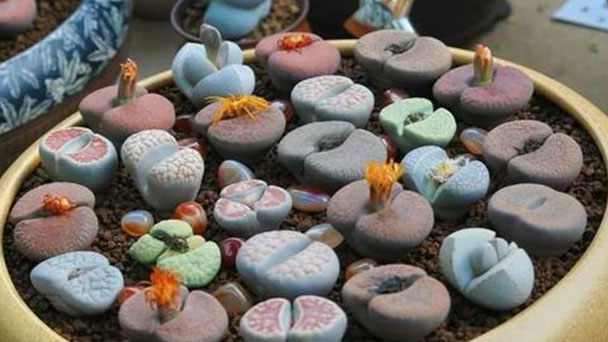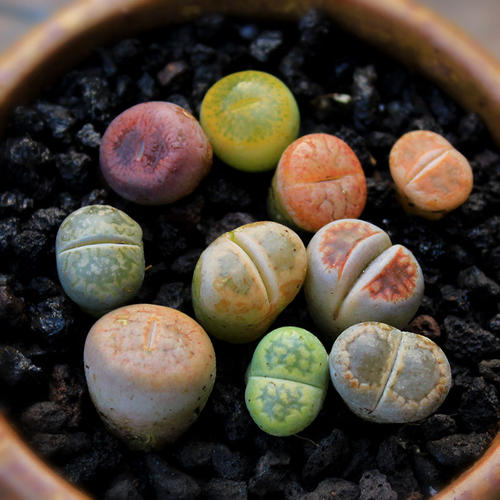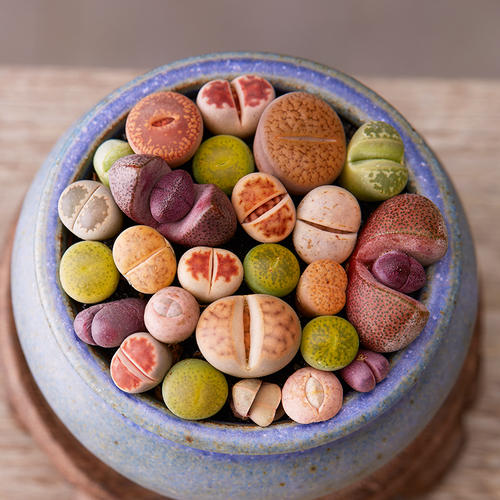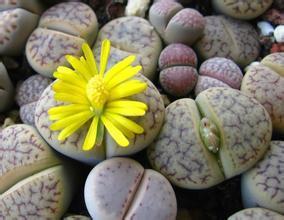Living Stone profile
Written by Maggie
Jan 05 2021

Because of its unique shape and colorful, Living Stone has become a popular ornamental plant. Native to southern Africa, grows and blossoms except during the rainy season. Living stones are hard to find in the gravel of their origin. This is due to their self-protective nature to prevent small animals from predation, which is called "mimicry".
Living Stones are native to south and southwest Africa and are commonly found in seams of rock beds and boulders. Living Stone is described as a "living stone". Living Stones only grow and flowering in the rainy days. Living stones are difficult to find in the gravel of origin, which is called "mimicry". Because of its unique form, colorful, it can be used as an ornamental plant.
Living Stone picture

Living Stone morphological characteristics
Living Stone is a perennial fleshy herb. Plant height is 2-3 cm. Plant inverted conical, apically subovoid, taupe. Living Stone has no stem, 2 leaves, opposite, base united, fleshy. Single flower from two leaves, 3 cm in diameter, golden yellow. The seeds are small. Flowering period: October-November, the spring of the following year.
Origin of Living Stone
Living Stone originated from southern Africa.
Growing environment of Living Stone
Living Stone likes warm climate in winter and cool climate in summer, warm and dry environment with sufficient sunshine. They are afraid of low temperature and avoid exposure to strong light. The suitable temperature for growth is 10-30℃.
Living Stone is suitable for growth in loose and breathable neutral sandy loam, winter and summer to reduce moisture appropriate help molting.
After flowering, the plant enters a dormant phase, in which new leaves develop at the central ministers inside the old leaves, and then the old leaves wilt and shed, providing nourishment for the new leaves. At the end of molting, the old leaves become completely dry and the new leaves enter the growing period.

https://www.rayagarden.com/how-to-garden/propagation-methods-of-living-stone.html
Living Stone main uses
Living Stone is a small indoor potted flower. Because of its mimicry shape, it is popular and widely cultivated, and can also be used as experimental materials for plant teaching.
Living Stone beautification effect
Living Stone plants' small, strange shape, is in the world's very popular indoor potted plants. Because its appearance resembles pebbles, therefore its basin soil surface often puts some and its form similar gravel, which can maintain basin soil humidity not only, and can increase admire interest more.

Latest Updated
- Benefits of Bugleweed - 7 Science-backed Health Benefits
- Bugleweed Dangers & Side Effects - Is It Poisonous?
- How to Plant Evergreen Trees - What You Should Know
- When to Plant Evergreens - Grow Guide for Evergreen Trees
- 12 Wonderful Evergreen Shrubs for Your Garden
- 12 Popular Evergreen Plants with Pictures for Beginners
- When And How To Prune A Lilac Bush Like a Pro
- How to Grow & Care for Lilac Vine (Hardenbergia Violacea)
- Japanese Lilac Tree (Syringa Reticulata) Care & Propagation Guide
- Shumard Oak Pros and Cons - What to Know
Popular Articles
- Winter maintenance of Antirrhinum Majus
- How to Grow Terminalia Mantaly Tree
- How to Grow and Care for Crossostephium Chinense
- How to grow Antirrhinum Majus in spring
- Peristeria Elata (Dove Orchid) Profile: Info & Care Guide
- Underwatered Snake Plant (Sansevieria Trifasciata) - Signs And How To Fix
- How to Care for Brazilian Jasmine Plant (Mandevilla Sanderi)
- How to Grow & Care for Graptopetalum Purple Delight in Summer
- Rosa Chinensis (China Rose): Plant Growing & Care Tips
- How to Care for Baby Sun Rose (Aptenia Cordifolia)